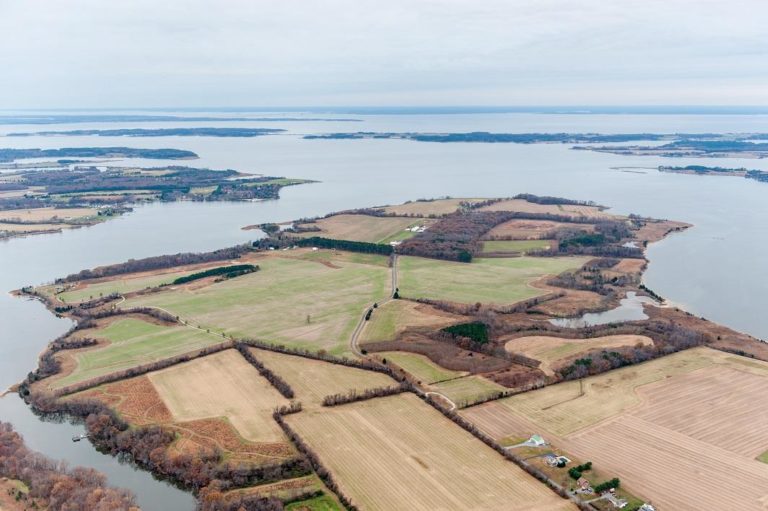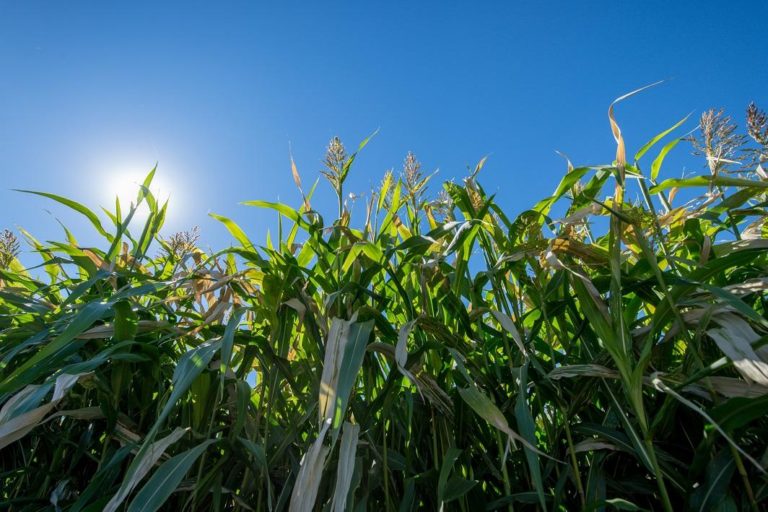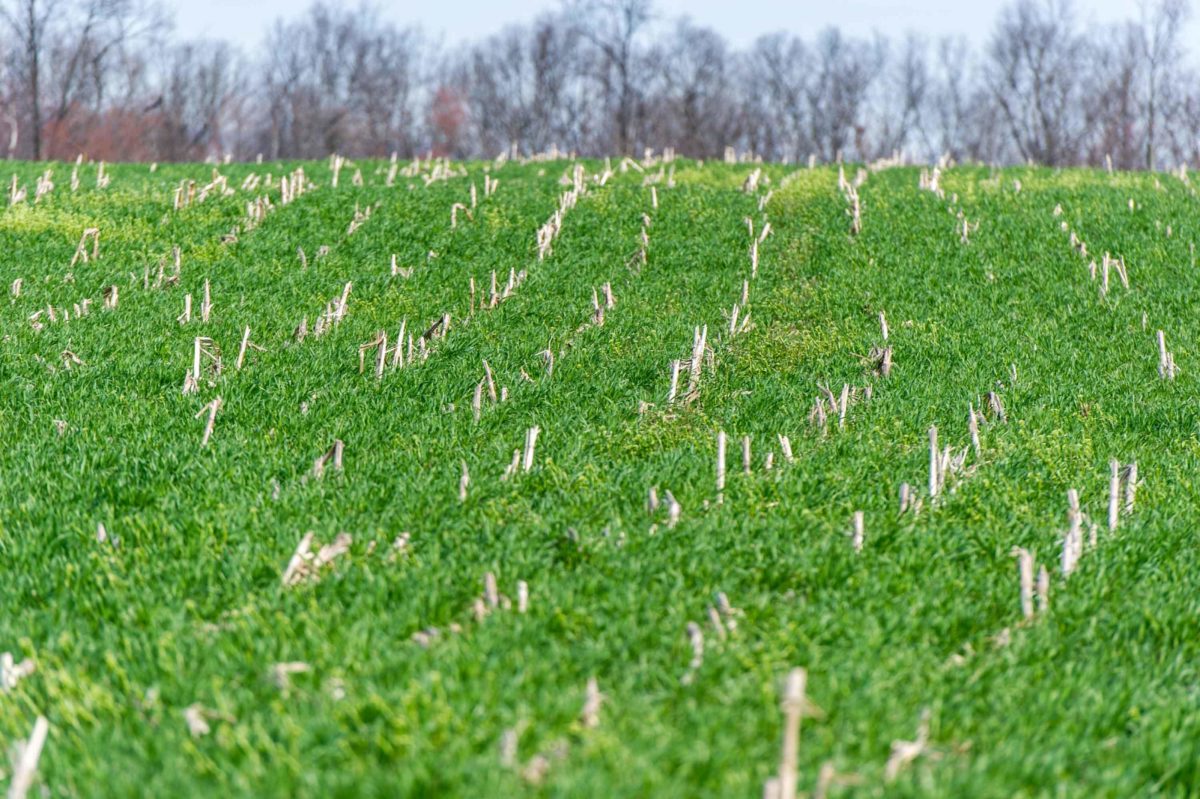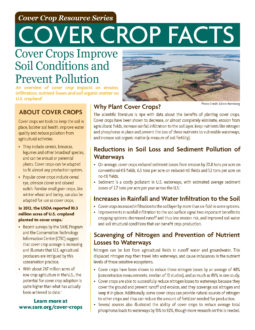An overview of cover crop impacts on erosion, infiltration, nutrient losses and soil organic matter on U.S. cropland.1

Download this fact sheet (PDF). This fact sheet is part of the Ecosystem Services from Cover Crops fact sheet series.
Why Plant Cover Crops?
The scientific literature is ripe with data about the benefits of planting cover crops. Cover crops have been shown to decrease, or almost completely eliminate, erosion from agricultural fields, increase rainfall infiltration to the soil layer, keep nutrients like nitrogen and phosphorus in place and prevent the loss of these nutrients to vulnerable waterways, and increase soil organic matter (a measure of soil fertility).
Reductions in Soil Loss and Sediment Pollution of Waterways
- On average, cover crops reduced sediment losses from erosion by 20.8 tons per acre on conventional-till fields, 6.5 tons per acre on reduced-till fields and 1.2 tons per acre on no-till fields.
- Sediment is a costly pollutant in U.S. waterways, with estimated average sediment losses of 2.7 tons per acre per year across the U.S.4
Increases in Rainfall and Water Infiltration to the Soil
- Cover crops increased infiltration to the soil layer by more than six-fold in some systems.
- Improvements in rainfall infiltration to the soil surface signal two important benefits to cropping systems: decreased runoff and thus less erosion risk, and improved soil water and soil structural conditions that can benefit crop production.
Scavenging of Nitrogen and Prevention of Nutrient Losses to Waterways
Nitrogen can be lost from agricultural fields in runoff water and groundwater. This displaced nitrogen may then travel into waterways, and cause imbalances in the nutrient levels of these sensitive ecosystems.
- Cover crops have been shown to reduce these nitrogen losses by an average of 48% (concentration measurements, median of 10 studies), and as much as 89% in one study.
- Cover crops are able to successfully reduce nitrogen losses to waterways because they cover the ground and prevent runoff and erosion, and they scavenge soil nitrogen and keep it in place. Additionally, some cover crops can provide natural sources of nitrogen to other crops and thus can reduce the amount of fertilizer needed for production.
- Several sources also illustrated the ability of cover crops to reduce average total phosphorus loads to waterways by 15% to 92%, though more research on this is needed.
Improved Soil Organic Matter Levels Signal Increased Soil Fertility and Soil Health

Soil organic matter is decomposed organic material (leaves, roots, microorganisms) that exists in the soil and acts as a reservoir of water and nutrients.
- Cover crops are able to increase soil organic matter by protecting the soil surface from erosion, adding biomass to the soil (especially below the soil surface), and creating a habitat for microorganisms like fungi that contribute to the soil biology and provide more pathways for nutrient management in the soil ecosystem.
- Legume cover crops were found to increase levels of soil organic matter by 8% to 114%.
- Non-legume cover crops, including grasses and brassicas, were found to increase soil organic matter levels by 4% to 62%.
Combining Management for Farm and Ecosystem Health
Cover crop management can be combined with no-till management and intentional manure management to create healthy conditions on the farm and in surrounding ecosystems.
- Like cover crop management, no-till management is also associated with reducing erosion and nutrient-loss risks in agricultural systems, especially when paired with cover crops and residue maintenance. One source showed that conservation tillage practices were responsible for an 89% reduction in soil loss as compared to conventional tillage.
- Manure application rates can be managed to mitigate losses of nitrogen and phosphorus to the soil, especially when cover crops are planted to offset any nutrient-loss risks posed by manure application.
A Proven Approach to Improving Our Ecosystems, Waterways and Soil Systems
The scientific consensus is in: cover crops reduce erosion, improve soil conditions and protect waterways from harmful nutrient loads. And, farmers and ranchers are curious about cover crops and are increasingly incorporating them into their systems. Though cover crop acreage has been rising each year, we still have enormous potential to increase the adoption of this beneficial practice and to improve our land and water quality for future generations.
About Cover Crops

Cover crops are tools to keep the soil in place, bolster soil health, improve water quality and reduce pollution from gricultural activities.
- They include cereals, brassicas, legumes and other broadleaf species, and can be annual or perennial plants. Cover crops can be adapted to fit almost any production system.
- Popular cover crops include cereal rye, crimson clover and oilseed radish. Familiar small grain crops, like winter wheat and barley, can also be adapted for use as cover crops.
1 Unless otherwise cited, all data comes from a bibliography compiled by SARE and the University of Missouri.
2 Myers, R. and C. Watts. 2015. Progress and perspectives with cover crops: interpreting three years of farmer surveys on cover crops. Journal of Soil and Water Conservation. 70(6):125A:129A.
3 National Agricultural Statistics Service. 2016a. Acreage.
4 Natural Resources Conservation Service. 2007 National Resources Inventory. National soil erosion results tables. www.nrcs.usda.gov/wps/portal/nrcs/detail/national/home/?cid=stelprdb1041678.
